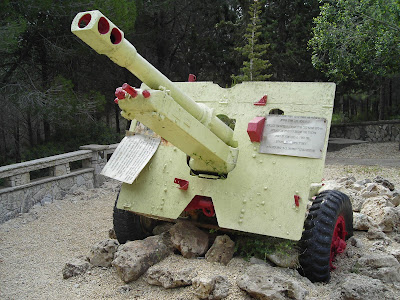
Following the 1936-1939 Arab revolt in Palestine, the British authorities built a number of police forts of similar design (named Tegart forts after their designer in various locations; Latrun was chosen as such a site due to its strategic significance, particularly its dominant position above the old Tel-Aviv-Jerusalem highway passing immediately below the hill-line. That police fort had an enormous impact on the outcome of the 1948 Arab-Israeli war. As the last British troops departed from Palestine Mandate on May 14, 1948, the fort was occupied by the Transjordanian Arab Legion.
The Legionnaires used the fort to shell Israeli traffic on the highway and thus effectively imposed the Siege of Jerusalem. During early June, a rough alternative route was developed to its south that was nicknamed "Burma Road" after the American and British route into Nationalist China during World War II.
Just 10 days after the declaration of Israel, on May 24, 1948, the fort was assaulted by combined forces of Israel's newly-created 7th Brigade, and a battalion of the Alexandroni Brigade (where Ariel Sharon served as a platoon commander; he was wounded with most of his platoon and later recalled the decision to retreat to a nearby vale as the most crucial tactical decision of his life). The attack (codenamed "Bin-Nun A") failed, with heavy casualties. A week later, on June 1st, the fort withstood yet another attack ("Bin-Nun B"), even though its outer defences were breached.

Many of the Israeli conscripts were recent survivors of the Holocaust and were new immigrants; most were poorly trained. The equipment was also very poor, and artillery support was lacking. The results of the battle were mixed. The official combined number of casualties for both the battles was 139 (an extremely high figure for an assault conducted mainly by two battalions). While the Tel-Aviv Jerusalem highway was not secured, the two Battles of Latrun can be seen as a limited strategic success, since they contained the Arab Legion and allowed the opening of the bypass road, which lifted the siege from Jerusalem.
In the 1949 cease-fire agreement, the fort remained a salient under Jordanian control, which was in turn surrounded by a perimeter of no man's land. Under the cease-fire agreement, Jordan was not to disrupt Israeli travelers using this road; in practice, constant sniper attacks led Israel to build a bypass road around the bulge.

In 1967's Six-Day War, Latrun was captured by Israeli forces, and the main-road to Jerusalem was reopened. The Tegart fort became a museum and a memorial site known as Yad La-Shiryon, which includes a display of over 110 tanks and other armored fighting vehicles (including the Merkava and T-72 tanks), an amphitheatre, an auditorium, a synagogue and a war memorial for fallen soldiers of Israeli Armored corps.

In 1970, an intentional community known as Neve Shalom (Oasis of Peace) was jointly founded by Israeli Arabs and Jews on a hilltop south of the Latrun ridge with the stated goal of engaging in educational work for peace and justice. In 1977, the Israeli settlement of Mevo Horon was built between Latrun and the West Bank proper to secure the Israeli claim to the region. Because of Latrun's strategic location above the most traveled highway in Israel, there is overwhelming consensus in Israel that the Latrun Salient won't be relinquished as part of any settlement to the Israeli-Palestinian conflict.
Today's hike was nice because we got some fresh blood on the trail with us in Ari and Dave, two guys who study at Yeshiva Aish HaTorah. Conversation can get a bit stale with the same people for days on end, so I think their presence really invigorated all of us. You may remember Dave as “The Tour Guide”, but unfortunately this internet is really really slow and we’ve only been able to get the video of Tel Dan up on the site. The best thing about him joining the crew was the delicious
cardamom coffee blend he brought with him. Hits the spot.
-Jeremy
No comments:
Post a Comment